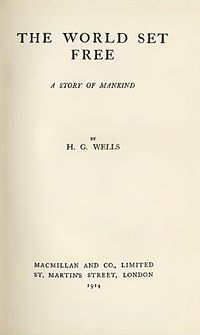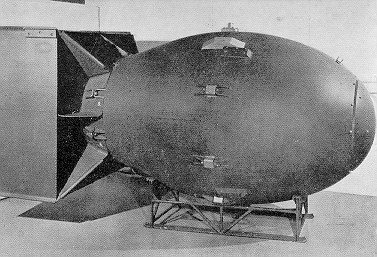The Influence of Science Fiction on Science
I wager that if scientists were honest in citing the role science fiction has in their scientific work, their published papers would be rife with footnotes referencing science fiction novels as well as journal articles. But for some reason, despite sci-fi’s pervasive influence in the world, that rarely happens. Here is a story of one time science fiction got its due.


In 1914 H. G. Wells published a novel entitled “The World Set Free”. It is not a very well known book, but in the novel Wells imagines a new kind of bomb, based on a nuclear chain reaction. In this science fiction story Wells imagines that atomic energy would be discovered in 1933 (20 years in his future), and that the bomb would first explode in 1956. Wells’ named his imaginary genius Holsten. Here is a snip from the book.
The problem which was already being mooted by such scientific men as Ramsay, Rutherford, and Soddy, in the very beginning of the twentieth century, the problem of inducing radio-activity in the heavier elements and so tapping the internal energy of atoms, was solved by a wonderful combination of induction, intuition, and luck by Holsten so soon as the year 1933.
Wikipedia notes “As fate or coincidence would have it, in reality the physicist Leó Szilárd read the book in 1932, conceived of the idea of nuclear chain reaction in 1933, and filed for patents on it in 1934.”
More from The World Set Free about the consequences of the first explosion of this atom bomb:
From the first detection of radio-activity to its first subjugation to human purpose measured little more than a quarter of a century. For twenty years after that, indeed, minor difficulties prevented any striking practical application of his success, but the essential thing was done, this new boundary in the march of human progress was crossed, in that year. He set up atomic disintegration in a minute particle of bismuth; it exploded with great violence into a heavy gas of extreme radio-activity, which disintegrated in its turn in the course of seven days, and it was only after another year’s work that he was able to show practically that the last result of this rapid release of energy was gold. But the thing was done–at the cost of a blistered chest and an injured finger, and from the moment when the invisible speck of bismuth flashed into riving and rending energy, Holsten knew that he had opened a way for mankind, however narrow and dark it might still be, to worlds of limitless power. He recorded as much in the strange diary biography he left the world, a diary that was up to that particular moment a mass of speculations and calculations, and which suddenly became for a space an amazingly minute and human record of sensations and emotions that all humanity might understand.
Wells’ imagined the bomb as something a terrorist would throw and not as a state-financed industrial achievement.
The gaunt face hardened to grimness, and with both hands the bomb-thrower lifted the big atomic bomb from the box and steadied it against the side. It was a black sphere two feet in diameter.

Lewis Larsen, who brought this remarkable story to my attention gives a little historical context.
Rutherford had proposed the modern concept of an atom (positive charges located in a central nucleus surrounded by a cloud of negatively charged “orbiting” electrons) in 1911 — a scant 2 years before Wells wrote this book. WWI hadn’t started yet — that began in 1914 and marked the first time that airplanes had been used in warfare. The University of Chicago exploding wire transmutation experiments by Wendt and Irion and their debate with Rutherford were still 8 years further in the future (1922); nuclear fission was not to be discovered for another 24 years (1938). In 1933 Rutherford pronounced ” The energy produced by the atom is a very poor kind of thing. Anyone who expects a source of power from the transformation of these atoms is talking moonshine.” The very first Trinity atomic bomb test at the Alamogordo Test Range was not until July 16, 1945, 31 years in the future of Well’s story.
There are many cases of science fiction authors forecasting aspects of the future correctly (and many more incorrectly). But it is rare when scientists admit to the influence of fiction in inventing this prophesied future.
As is evident from Wells’ reference in the text, he was aware of the earliest reports of radioactivity by the scientists Ramsay, Rutherford and Soddy, who had discovered the disintegration of uranium. In turn they seemed to be aware of Wells’ novel. In fact, as Wikipedia notes, Soddys book called Wealth, Virtual Wealth, and Debt praises The World Set Free.
The influence of Wells’ fictional story of an invention on the actual invention was confirmed by Dick Garwin’s in his 2001 book, Megawatts and Megatons. Larsen passed me this excerpt which I have slightly edited for clarity.
In 1932, Szilard read the H. G. Wells novel The World Set Free, published in 1914, in which the major cities of the world are destroyed by atomic bombs in 1956. In November 1938 Szilard moved to New York. By December 1938, Fermi had left Italy with his family to receive the Nobel Prize in Sweden, intending not to return. Arriving in New York on January 2, 1939, he was welcomed to the physics department at Columbia University. Two weeks later, Fermi and his wife, Laura, greeted Bohr as he came from Denmark with the as-yet-unpublished news that Meitner and Frisch had confirmed the process of nuclear fission by radiochemical experiments (i.e., using chemistry to characterize the radioactive materials resulting from neutron-induced fission of uranium). Fermi was interested in fission as a new physical phenomenon, but Szilard saw in fission the realization of his five-year fixation on the chain reaction and the near certainty of nuclear explosives as forecasted by H. G. Wells.
Part of Well’s ability to influence scientists came from his immense imagination, capable of describing not only an invention, but more importantly, the consequence of that invention. Long before any of the scientists working on the atomic bomb did, Wells foresaw the global political “fallout” an atom bomb would bring. In his eyes the atomic bomb would begin “the Last War.” In Section 5 of his novel he unrolls this astounding vision of a nuclear age.
Certainly it seems now that nothing could have been more obvious to the people of the earlier twentieth century than the rapidity with which war was becoming impossible. And as certainly they did not see it. They did not see it until the atomic bombs burst in their fumbling hands. Yet the broad facts must have glared upon any intelligent mind. All through the nineteenth and twentieth centuries the amount of energy that men were able to command was continually increasing. Applied to warfare that meant that the power to inflict a blow, the power to destroy, was continually increasing. There was no increase whatever in the ability to escape. Every sort of passive defence, armour, fortifications, and so forth, was being outmastered by this tremendous increase on the destructive side. Destruction was becoming so facile that any little body of malcontents could use it; it was revolutionising the problems of police and internal rule. Before the last war began it was a matter of common knowledge that a man could carry about in a handbag an amount of latent energy sufficient to wreck half a city. These facts were before the minds of everybody; the children in the streets knew them. And yet the world still, as the Americans used to phrase it, ‘fooled around’ with the paraphernalia and pretensions of war.


